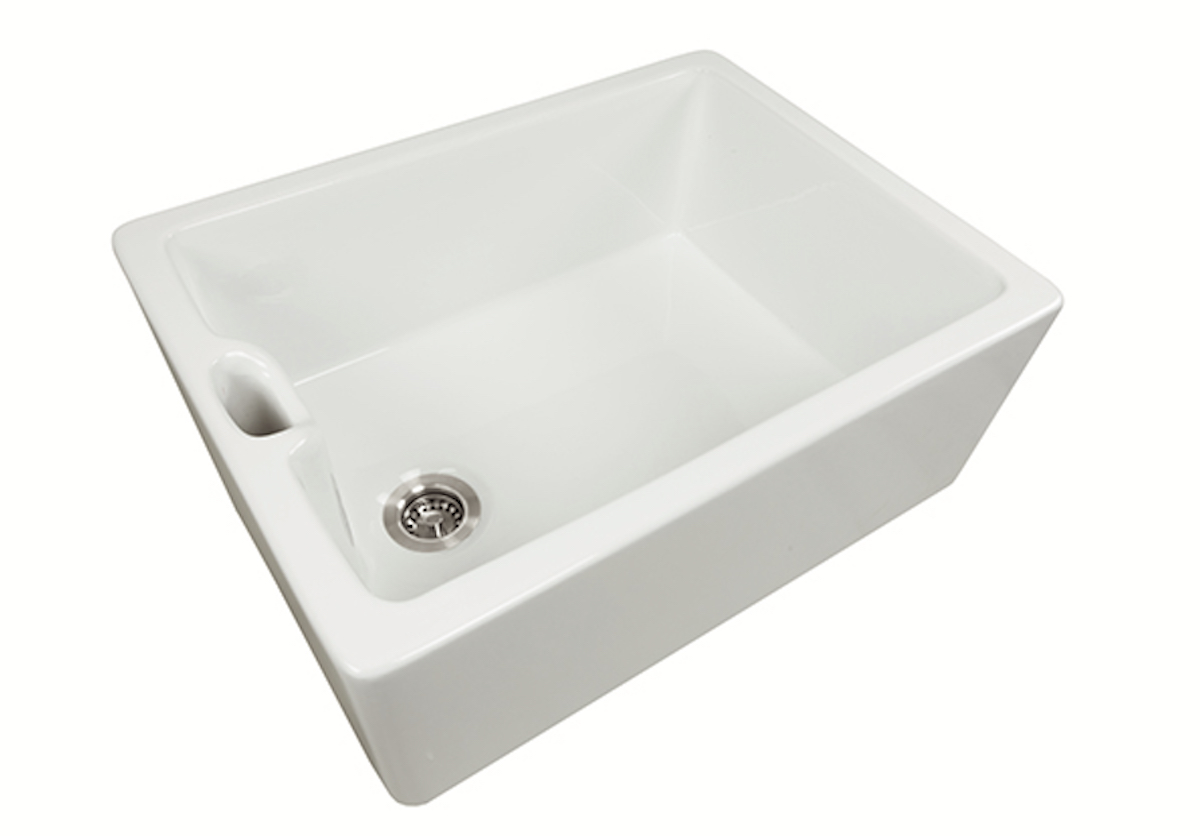What Is A Butler Sink

Welcome to our comprehensive guide of the Butler sink.
The Butler sink has been a prominent feature in British kitchens for centuries.
In this post, we'll delve into what a Butler sink is, its unique history, distinctive characteristics, and why it continues to remain a popular choice among homeowners.
Whether you're contemplating a kitchen remodel or simply wish to understand more about this classic piece, you're in the right place.
Click here to view our range of Belfast Sinks.
What Is A Butler Sink?
A Butler sink, also known as a London sink, is a type of sink that originates from the UK and shares many characteristics with the Belfast sink.
Traditionally, Butler sinks are a deep, rectangular, ceramic sink that is exposed at the front, often associated with country-style or farmhouse kitchens due to their classic design and robustness.
However, unlike Belfast sinks, which have a built-in overflow due to historical plumbing regulations in Belfast, Butler sinks typically do not have an overflow system.
This design feature is because, in London where Butler sinks originate, there was less availability of fresh water, so every drop counted and overflow holes were not incorporated into the design.
Nowadays, the terms Belfast and Butler are often used interchangeably, and modern versions of both types of sinks may or may not include an overflow.
Despite this, they continue to be a popular choice for both traditional and contemporary kitchens due to their timeless appeal, practicality, and durability.
Click here to view our range of Belfast Sink Waste Kits for sale online.
How To Clean A Butler Sink
Keeping your Butler sink in top condition involves regular cleaning with suitable products.
Here's how you can maintain your Butler sink's pristine look:
- Daily Cleaning: Use a mild dish soap and warm water for daily cleaning. Avoid abrasive cleaners or scrubbers as they can scratch the sink's surface. Apply the soapy water with a soft sponge or cloth and rinse thoroughly afterwards.
- Tackle Stains: For stubborn stains, you can create a paste of baking soda and water. Apply this paste to the stain and let it sit for 15-20 minutes. Then, gently scrub with a soft cloth or sponge and rinse thoroughly. Avoid using bleach or ammonia-based cleaners as they can discolour the sink.
- Shine and Polish: For an extra shine, you can wipe the sink down with white vinegar. This natural cleaner helps to remove water spots and gives the sink a nice shine. Just apply the vinegar with a cloth, then rinse and dry.
- Prevent Scratches and Chips: Use a sink protector or a rubber mat to protect the bottom of the sink from heavy pots and pans. Avoid dropping sharp or heavy objects into the sink.
- Prevent Discolouration: Rinse your sink thoroughly after using any cleaning agents and dry with a soft cloth to prevent water spots and mineral deposits from forming.
Remember, each Butler sink can be slightly different depending on the materials used, so always refer to the manufacturer's cleaning instructions.
Regular cleaning and proper care will keep your Butler sink looking beautiful for years to come.
Click here to view our range of Belfast Sink Taps for sale online.
How To Fit A Butler Sink
Installing a Butler sink, often referred to as a farmhouse sink, can be a significant upgrade to your kitchen.
Here's a step-by-step guide on how to fit a Butler sink:
- Take Measurements: Measure the width, depth, and height of your sink. Ensure that your cabinet and countertop can accommodate these measurements.
- Prepare the Cabinet: You may need to modify the cabinet to fit the sink. This could involve cutting out a section of the cabinet and adjusting the height of the cabinet doors. Make sure to reinforce the structure as Butler sinks can be quite heavy.
- Create a Support Frame: Build a support frame within the cabinet to hold the weight of the sink. The top of this frame should be level with the top of the cabinet sides to allow the sink to slide in.
- Cut the Countertop: Mark the outline of the sink on the countertop, then cut along these lines. Ensure the cutout is accurately measured to avoid gaps or an overly tight fit.
- Install the Sink: Slide the sink into the cutout and rest it on the support frame. It should fit snugly into the countertop cutout.
- Seal the Edges: Apply silicone sealant around the edges of the sink where it meets the countertop to create a waterproof seal.
- Connect the Plumbing: Attach the faucet, drain, and dishwasher hookup, if applicable. Ensure all connections are secure to prevent leaks.
This is a general guide and the exact process may vary depending on your specific sink and kitchen setup.
If you're unsure, it might be best to hire a professional plumber to ensure the sink is installed correctly and safely.
Always make sure to follow any manufacturer's installation instructions that come with your specific Butler sink.
Click here to view our range of Belfast Sink Accessories.
What Is The Difference Between Butler And Belfast Sinks?
While Butler and Belfast sinks are similar in their deep, rectangular design and farmhouse aesthetic, there are a few key differences between the two, mostly stemming from their geographical origins and historical use.
- Overflow: A significant distinction between the two sinks is the inclusion of an overflow. Belfast sinks, named after the capital of Northern Ireland, have an overflow due to the plentiful supply of water in that region. Butler sinks, on the other hand, originated in London where water was historically more scarce, so they typically don't have an overflow to prevent accidental water waste.
- Size: Belfast sinks tend to be larger and deeper than Butler sinks, reflecting the larger quantities of water available in Belfast compared to London. This can influence the overall look of the sink in your kitchen, as well as its practical usage.
- Installation: Both sinks can be installed in a similar manner, but traditionally, Butler sinks were often installed slightly protruding from the kitchen counter, while Belfast sinks were usually flush with or slightly beneath the worktop level.
- Design Variations: Both Belfast and Butler sinks are traditionally single-bowl designs. However, in modern adaptations, you'll find variations including double bowl designs.
While there are some differences between the two, both Belfast and Butler sinks offer a timeless aesthetic and practicality that make them a popular choice for a variety of kitchen styles.
The best choice for your kitchen will depend on your specific needs, aesthetic preferences, and water usage considerations.
How Much Does A Butler Sink Weigh?
The weight of a Butler sink can vary significantly depending on the material from which it is made and its size.
- Fireclay Butler sinks: These are the most traditional and are usually the heaviest. A standard-sized fireclay Butler sink can weigh around 40-50 kilograms, although larger models can weigh significantly more.
- Ceramic Butler sinks: These are often slightly lighter than their fireclay counterparts. A standard ceramic Butler sink may weigh between 30-40 kilograms.
- Stainless steel Butler sinks: These are usually the lightest option. A stainless steel Butler sink might weigh anywhere from 15-25 kilograms.
It's essential to consider the weight of the sink during installation, as it will need adequate support, especially for heavier fireclay or ceramic models.
Additionally, weight may factor into your decision if you're planning to install your sink in an existing countertop or cabinet, as not all structures may be suitable to support a heavy sink.
Always remember to check the weight and installation guidelines before purchasing a Butler sink.

